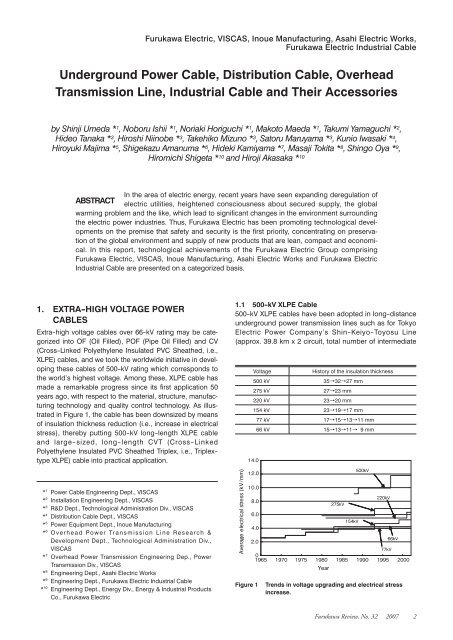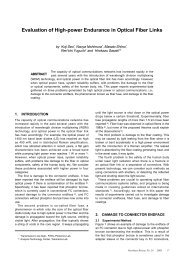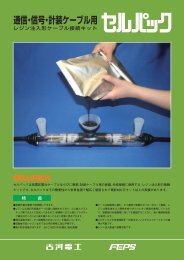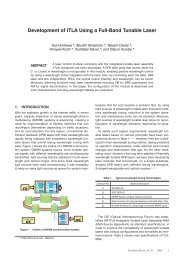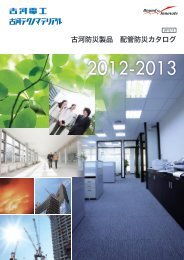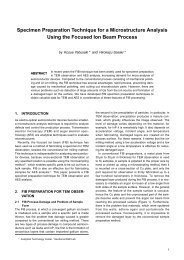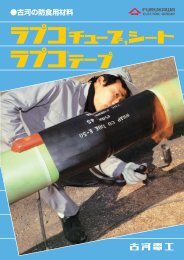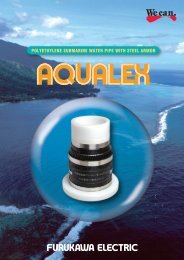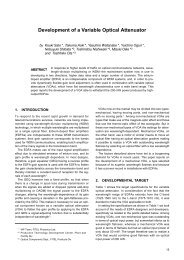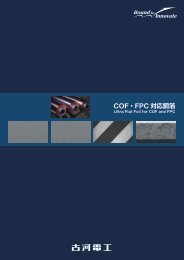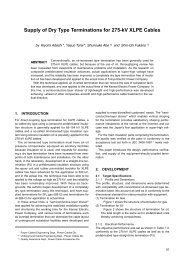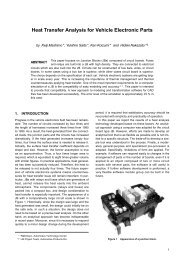Underground Power Cable, Distribution Cable, Overhead
Underground Power Cable, Distribution Cable, Overhead
Underground Power Cable, Distribution Cable, Overhead
You also want an ePaper? Increase the reach of your titles
YUMPU automatically turns print PDFs into web optimized ePapers that Google loves.
<strong>Underground</strong> <strong>Power</strong> <strong>Cable</strong>, <strong>Distribution</strong> <strong>Cable</strong>, <strong>Overhead</strong> Transmission Line, Industrial <strong>Cable</strong> and Their Accessories<br />
joint: 240 phase, maximum span: 1,800 m), as well as in<br />
outgoing lines from power plants. Figure 2 shows a scene<br />
of cable installation for the Kan’nagawa Hydraulic <strong>Power</strong><br />
Plant of Tokyo Electric <strong>Power</strong> Company in 2003. Because<br />
the cable was so long in unit length as to reach 1,800 m,<br />
ordinary methods were unable to deal with its transportation.<br />
Accordingly, the cable was transported from the<br />
manufacturing plant to Hitachi Port by sea, and from<br />
where to the power plant by land using a special-purpose<br />
vehicle under a restriction of nighttime-only traveling,<br />
spending an unprecedentedly long transportation time of<br />
seven days.<br />
With respect to connection with the power equipment,<br />
an inverted type of gas-immersed termination joint was<br />
needed, so that we developed a new joint after reviewing<br />
its inner structure, having succeeded in delivery ahead of<br />
other manufacturers.<br />
We have accumulated several track records of 500-kV<br />
XLPE cables domestically since then, and having gained<br />
a foothold in overseas market through our recent delivery<br />
to China, we plant to receive more orders from overseas.<br />
1.2 <strong>Cable</strong> Downsizing and Capacity Increase<br />
We have developed jointly with Tokyo Electric <strong>Power</strong><br />
Company the Triplex-type XLPE cable having a sectored<br />
cross-section shown in Figure 3, and have applied the<br />
cable to many practical transmission lines since 1998. It<br />
was intended that the new cable design would be applied<br />
to increase the transmission capacity (i.e., increasing the<br />
Figure 2 Installation of a long-length cable using a specialpurpose<br />
vehicle.<br />
Figure 3 Appearance of sectored Triplex-type XLPE cable.<br />
conductor size) while making efficient use of existing<br />
cable conduits, because the costs related with civil engineering<br />
work to construct new cable conduits were very<br />
expensive. This development has made it possible to<br />
apply 500-mm 2 sized cables to those transmission lines<br />
where the maximum cable size was limited to 325 mm 2<br />
due to the duct size restriction, thereby achieving a<br />
capacity increase.<br />
1.3 Large-Sized Triplex-type XLPE <strong>Cable</strong><br />
Although the largest conductor size of Triplex-type XLPE<br />
cables was conventionally limited to 600 mm 2 due to<br />
manufacturing difficulties, we have overcome these problems<br />
and subsequently investigated the characteristic<br />
thermal behavior of large-sized segmented conductor<br />
cables at the time of stranding. As a result, taking into<br />
account these results in installation design, we were able<br />
to expand the size of 66-kV and 154-kV Triplex-type<br />
XLPE cables up to 1,000 mm 2 . The specification based on<br />
these results has been adopted since 2005 as a standard<br />
for practical lines, resulting in a number of improvements<br />
such as reducing the space for cable accommodation,<br />
efficiency increase in cable laying (i.e., enabling laying of<br />
three phases in a shorter period of time), reducing the line<br />
construction costs and downsizing of manholes due to<br />
elimination of cable offset.<br />
1.4 DC XLPE <strong>Cable</strong><br />
There is much need for DC transmission cables for its<br />
higher power transmission efficiency with no AC losses.<br />
Until recently, AC power transmission was preferred to DC<br />
transmission due to the fact that AC-DC power converters<br />
to be installed at either end of the cable line are expensive<br />
thus causing an increase in total construction cost. As the<br />
cost of power converter decreases, however, application<br />
of DC power transmission is expected to expand.<br />
But, in developing DC XLPE cables, it was found that<br />
the AC insulation material (i.e., cross-linked polyethylene)<br />
was not directly applicable to DC cables due to the problem<br />
of space charge accumulation within the insulation<br />
material. Accordingly, we have developed a DC insulation<br />
material which can control space charge accumulation,<br />
and have confirmed that the prototyped DC 250-kV and<br />
500-kV XLPE cables are provided with superior electrical<br />
properties including long-term characteristics.<br />
Figure 4 Large-sized Triplex-type XLPE cable and its installation.<br />
Furukawa Review, No. 32 2007 3
<strong>Underground</strong> <strong>Power</strong> <strong>Cable</strong>, <strong>Distribution</strong> <strong>Cable</strong>, <strong>Overhead</strong> Transmission Line, Industrial <strong>Cable</strong> and Their Accessories<br />
Moreover, taking advantage of the DC cable technology<br />
mentioned above, we have recently embarked on the<br />
development of coaxially-integrated return conductor DC<br />
XLPE cables (i.e., DC coaxial cables), in which the main<br />
DC cable and the return cable are integrated into a single<br />
cable, and the development has advanced to the stage of<br />
the 250-kV class.<br />
1.5 Submarine <strong>Cable</strong><br />
There are firm demands for submarine cables both at<br />
home and abroad.<br />
In 2004, we have delivered to the Matsushima-Narao<br />
Line of Kyusyu Electric <strong>Power</strong> Company connecting the<br />
Matsushima Substation on the Kyushu mainland side and<br />
the Narao Substation on the Goto side a large volume of<br />
66-kV optical fiber-composite submarine power cable in<br />
lump-sum, totaling approximately 2,670 ton in mass and<br />
54 km in length, which equals the world-class length as<br />
an AC triplex XLPE submarine cable. The Line comprised<br />
two cable lines, and the cable laying work was carried<br />
out, under the direction of Kyusyu Electric <strong>Power</strong><br />
Company, by a joint venture consisted of four companies<br />
headed by Furukawa Electric.<br />
Although the cable structure had a proven track record,<br />
the unexperienced length of the cable made it indispensable<br />
to factory joint the power cable and the optical fiber<br />
unit. Accordingly, in addition to the conventional inspection<br />
items specified in the CIGRE recommendations, we<br />
have reviewed the history of procedures that the cable is<br />
anticipated to undergo ranging from manufacturing at the<br />
plant to final installation at the site, and, after designing<br />
the cable taking these results into consideration, we confirmed<br />
the validity of the design by verification.<br />
In this cable laying work done by the four-company<br />
joint venture, a cable laying ship built by using pure<br />
domestic technologies and provided with the dynamic<br />
positioning system (DPS) “Tenzan” played an active role<br />
(see Figure 8). The ship traveled, in a complete DPS<br />
scheme without using anchor at all, the whole 54-km<br />
route to lay and bury the cable at a pace of one line in ten<br />
days (day and night).<br />
High-accuracy cable laying with an accuracy of not<br />
Figure 5 500-kV DC XLPE Figure 6 ±250-kV DC coaxial<br />
cable. submarine power cable.<br />
more than ±5 m for straight sections and not more than<br />
±10 m for curved sections has been achieved. The cable<br />
burial depth was set at 1.5 m to avoid damages due to<br />
anchoring. In terms of burial method, the simultaneous<br />
laying and burying method was applied where a cable<br />
paid out from a laying ship is immediately buried by a<br />
burying machine that is tugged by the laying ship (see<br />
Figure 9).<br />
It is expected that, as a result of this achievement,<br />
Figure 7 Appearance of typical submarine cable.<br />
Figure 8 <strong>Cable</strong> laying ship “Tenzan” with DPS function, built<br />
by using pure domestic technologies.<br />
Figure 9 Conceptual image of simultaneous laying and burying<br />
using a cable laying ship with DPS function.<br />
Furukawa Review, No. 32 2007
<strong>Underground</strong> <strong>Power</strong> <strong>Cable</strong>, <strong>Distribution</strong> <strong>Cable</strong>, <strong>Overhead</strong> Transmission Line, Industrial <strong>Cable</strong> and Their Accessories<br />
demand for isolated island connection cables over long<br />
distances will grow in future.<br />
2. JOINT FOR HIGH-VOLTAGE XLPE<br />
CABLES<br />
Because XLPE cable is characterized by its ease of maintenance,<br />
the cable rapidly proliferated domestically in the<br />
1960s when its application began, currently constituting<br />
the majority of domestic power cables having voltage ratings<br />
of 66-kV and higher. During this period, we have<br />
developed the sealing end and the extrusion molded joint<br />
for XLPE cable joints, achieving significant improvements<br />
in terms of performance, ease of installation, reduction of<br />
joint size and so forth.<br />
As the cable rating was upgraded from the 66-kV class<br />
to the 154-kV, 275-kV and further to the 500-kV class, we<br />
carried out development concentrating on the reliability<br />
and work management of joints, thereby achieving an<br />
extremely low rate of dielectric breakdown across the<br />
world. Moreover, since the late 1990s when 500-kV XLPE<br />
cables have been put into actual use, studies have been<br />
made focusing on simplifying the installation process for<br />
joints as well as reducing their sizes, and new joints that<br />
utilize new structures and materials have been developed<br />
for practical application.<br />
A rubber block-based intermediate joint named cold<br />
shrinkable joint (CSJ) is one of these developments,<br />
which is aimed at simplifying the installation process. The<br />
structure of CSJ is such that a rubber block insulator (see<br />
Figure 10) that is molded at the factory in advance is used<br />
as a reinforcing insulator to fit to the cable joint. The CSJ<br />
has achieved, due to its simple structure, a significant<br />
reduction in installation time and simplification of work<br />
management when compared with taped joints where an<br />
insulating tape is wound at the work site, or with field<br />
molded joints where cross-linked polyethylene is used to<br />
integrally mold the cable at high pressure and high temperature.<br />
Currently the CSJ is practically applied to the<br />
154-kV class domestically as well as to the 220-kV class<br />
overseas, and the one for 400 kV has already been devel-<br />
Figure 10 Rubber block insulator for 220-kV rating.<br />
oped, so that its application area is growing. Moreover,<br />
aiming at simplification of installation work, we are presently<br />
developing a simplified termination which applies<br />
rubber block insulator and oil to a termination, whereby<br />
the 110-kV class has already been put into practical<br />
application, while the 220-kV class is under development.<br />
As for termination using new materials, on the other<br />
hand, a composite-type termination has been developed,<br />
which is based on composite insulator that consists of<br />
FRP insulator and silicone rubber sheds instead of porcelain<br />
insulator. Because the composite insulator is lighter<br />
than porcelain insulator, it is considerably advantageous<br />
in that the assembly work can be carried out safely in a<br />
shorter period of time without using heavy machinery.<br />
With respect to electrical characteristics, it has been confirmed<br />
that the composite insulator is comparable to or<br />
better than porcelain insulator due to the water-shedding<br />
property of silicone rubber. While the composite insulator<br />
has been applied to the 154-kV class presently, it is<br />
expected that the application will grow to higher-voltage<br />
regions in the future.<br />
In addition, an insulation oil-free, 77-kV class dry composite<br />
type termination (see Figure 11) has been developed,<br />
which utilizes silicone rubber for the outer jacket<br />
molded on an epoxy insulator. The termination is advantageous<br />
in that free-angle installation is allowed for; no oil<br />
leak occurs making it environment friendly; and jointing<br />
work of cable takes only a short time because compact<br />
versions of the CSJ mentioned above are used.<br />
Introduction of dry composite type terminations to higher<br />
voltage ratings has just begun, so that the application is<br />
expected to expand in the future.<br />
Furthermore, we have two kinds of compact joints,<br />
namely: compact transition joint for different types of<br />
cables such as the XLPE and OF cables; and compact Ybranch<br />
joint (see Figure 12) for three XLPE or OF cables.<br />
These achievements have been realized by accumulating<br />
design technologies, whereby the structural dimensions<br />
Figure 11 Dry composite type termination for 77-kV rating.<br />
Furukawa Review, No. 32 2007
<strong>Underground</strong> <strong>Power</strong> <strong>Cable</strong>, <strong>Distribution</strong> <strong>Cable</strong>, <strong>Overhead</strong> Transmission Line, Industrial <strong>Cable</strong> and Their Accessories<br />
and degraded brittleness, so that it is necessary to take<br />
proper measures before applying them to electric wires<br />
again. Even though the recovered PVC materials are<br />
kneaded after adding stabilizer and plasticizer so as to<br />
improve their characteristics, the recycled materials are<br />
still inferior to new materials such that it is difficult to apply<br />
some specified color markings on their surface.<br />
Accordingly, in application to wire sheathing, a two-layered<br />
structure is adopted: recycled material for the inner<br />
layer and new material for the outer layer. The use of new<br />
material on the outer layer makes it possible to distinguish<br />
phases by coloring, and the appearance becomes comparable<br />
to that of conventional wires. Thus, we have<br />
achieved the reuse of recovered PVC material to electric<br />
wire sheathing by means of material property management,<br />
improvement of recycling kneading techniques and<br />
the adoption of two-layered structure. The recycling of<br />
PVC is currently applied to the IV, DV and SV wires.<br />
(2) Recycling of PE<br />
As for the recycling of PE, recovered PE from OE wire is<br />
pelletized into recycled PE to be used in sheathing of OE<br />
wire again. PE sheathing recovered from Tokyo Electric<br />
<strong>Power</strong> Company ---colored in black by its nature containing<br />
weather resistant carbon--- was found to be rather<br />
stabilized in the quality, so that it was concluded that<br />
application to wire sheathing would pose no problems if<br />
the quality of recovered lots are properly managed. The<br />
characteristics of prototyped OE wires fully satisfied the<br />
wire specifications despite their somewhat roughened<br />
surface. The recycled OE wire has acquired Tokyo Electric<br />
<strong>Power</strong> Company’s type certification leading to continued<br />
delivery. Also, the recycled PE material is being applied to<br />
plastic drums for wires, expanding its applications.<br />
(3) Recycling of XLPE<br />
XLPE is a cross-linked polyethylene with improved heat<br />
resistance. Cross-linked structure results in low fluidity<br />
above the melting temperature of a material, capable of<br />
sustaining the original shape. This made it difficult to<br />
reprocess the recovered XLPE using extrusion and the<br />
like, so that conventionally recovered materials were disposed<br />
of as fuel by thermal recycling or as industrial<br />
waste. We have developed a melt & shear kneading<br />
method, in which suitable amounts of heat and shear are<br />
applied to XLPE to break down the cross-linked structure<br />
thereby reducing the molecular weight. In this way the<br />
recovered XLPE can be reprocessed using ordinary extrusion<br />
forming. Because the recovered XLPE is forcibly<br />
reduced in the molecular weight, its mechanical characteristics<br />
like elongation are significantly lowered.<br />
Accordingly, in applications to wire sheathing, the material<br />
was mixed with virgin PE to improve the deteriorated<br />
characteristics, and it was found that if the mixing ratio of<br />
the recovered material is not more than 25%, the resultant<br />
material is comparable to virgin materials. This recycled<br />
material can be cross linked by either the water vapor or<br />
silane cross-linking processes, and is applicable to OC<br />
wire using regular manufacturing processes. This recy-<br />
cled OC wire also acquired a type certification from Tokyo<br />
Electric <strong>Power</strong> Company, and was delivered to the same<br />
company (see Figure 19).<br />
4. CABLE ACCESSORIES FOR<br />
UNDERGROUND DISTRIBUTION<br />
4.1 Joint for 6.6-kV XLPE <strong>Cable</strong><br />
Joints for underground distribution cables have ever<br />
undergone changes to adapt themselves to the cable<br />
structures of the times. Specifically after 1970, as XLPE<br />
cables have evolved to become established, solder jointing<br />
of conductors has been replaced by compression<br />
jointing using neither torch nor heat reducing jointer<br />
errors, together with prefabricated joints which need no<br />
tape wrapping for insulation. As for 6.6-kV cables, such<br />
joints have come into practical applications and are widely<br />
used including slip-on type straight-through joints,<br />
slip-on type terminations and porcelain bushing type terminations.<br />
Since around 2000, cold shrinkable terminations have<br />
been used, with which, as shown in Figures 20 and 21,<br />
the main body of a joint is expanded beforehand at the<br />
factory over a supporting core, which is removed after<br />
cable conductor jointing and insulation shaping to make<br />
the main body fit on the cable. The main body uses silicone<br />
rubber having superior contamination resistance<br />
and mechanical as well as electrical characteristics, with<br />
an aim to improve reliability and workability.<br />
Intermediate joints such as straight-through joint and<br />
Y-branch joint also use silicone rubber, and cold-shrinkable<br />
joints have come into practical applications in order<br />
to reduce the number of parts and to improve workability.<br />
The structure of Y-branch joint is such that a spacer<br />
with a built-in electric stress relief function is mounted on<br />
each core conductor, on which an insulation housing is<br />
cold-shrunk. A waterproof spacer is mounted on the ends<br />
of two branches to waterproof them in block using a<br />
waterproof tape, aiming at workability improvement and<br />
downsizing of the joint.<br />
The Y-branch joint is practically applied in the field as a<br />
component of the so-called “soft” underground distribution<br />
cabling system. Conventionally underground installation<br />
of distribution cables required that a tower for circuit<br />
breakers be installed on the ground for branching, thus<br />
necessitating a certain width for the sidewalk. Application<br />
Figure 19 OC wire using recycled material.<br />
Furukawa Review, No. 32 2007
<strong>Underground</strong> <strong>Power</strong> <strong>Cable</strong>, <strong>Distribution</strong> <strong>Cable</strong>, <strong>Overhead</strong> Transmission Line, Industrial <strong>Cable</strong> and Their Accessories<br />
Removed accessories collected in this manner are<br />
properly sorted and pulverized for further applications<br />
including reuse as a distribution line component, for<br />
which prototyping is underway. This program is attaining<br />
good results in many fields and accordingly, we are<br />
studying its feasibility as a business. There are concerns,<br />
however, that removal, sorting and productization can be<br />
costly for recycling the removed accessories, so that a<br />
comprehensive study that takes these factors into account<br />
is needed.<br />
5. OVERHEAD TRANSMISSION LINE<br />
5.1 Aluminum Conductor<br />
In the beginning, aluminum conductors for overhead<br />
transmission lines were manufactured from pure aluminum<br />
(ECAL), using wire rods made by the hot-rolling and<br />
extrusion methods. Later on, in response to the increased<br />
demand for aluminum conductors, continuous castingand-rolling<br />
methods such as the Propelti method were<br />
developed to improve productivity. During the 1960s and<br />
1970s, various aluminum alloys for electrical conductors<br />
have been developed that are characterized by strength,<br />
heat-resistance and electrical conductivity, respectively.<br />
In particular, a heat-resistant aluminum alloy conductor<br />
(TAL) with an enhanced power transmission capacity has<br />
been developed in order to meet the rapidly increased<br />
power demand at the time of high economic growth in the<br />
1960s, and the conductor has been used in abundance<br />
up to the present date. This was followed by the development<br />
of a extra thermo-resistant aluminum alloy conductor<br />
(XTAL) with much improved heat resistance, and a<br />
60% heat conductivity super thermo-resistant alloy conductor<br />
(ZTAL) which realized improvements in both electrical<br />
conductivity and heat resistance; and both of them<br />
have come to practical use. An electric power conductor<br />
is configured using these aluminum alloy conductors suitably<br />
selected depending on applications, which are<br />
arranged around the central steel or aluminum-clad steel<br />
wires to constitute a corrosion-resistant stranded wire.<br />
Table 3 shows the properties of various heat-resistant,<br />
high-strength aluminum alloy conductors.<br />
Table 3 Properties of various heat-resistant, high-strength<br />
aluminum alloy conductors.<br />
Type<br />
Electrical<br />
Tensile strength<br />
Working temperature (°C)<br />
conductivity<br />
(MPa)<br />
(% IACS) Continuous Short time Instantaneous<br />
HAL 157~196 61 90 120 180<br />
TAL 157~196 60 150 180 260<br />
KAL 225~255 58 90 120 180<br />
KTAL 225~255 55 150 180 260<br />
UTAL 157~196 57 200 230 260<br />
ZTAL 157~196 60 210 240 280<br />
XTAL 157~196 58 230 310 360<br />
5.2 OPGW<br />
Optical ground wire (OPGW) is an overhead grounding<br />
wire to effect grounding of overhead transmission lines, in<br />
which optical fibers are integrated to provide communication<br />
functions. OPGWs enable long-distance, high-quality<br />
data transmission as well as video transmission without<br />
being affected by electromagnetic fields in any way, so<br />
that it is utilized as a transmission line for remote control<br />
of unattended power plants and substations in addition to<br />
communications between power plants. Aluminum-clad<br />
steel wires used in OPGWs are manufactured using conform<br />
extrusion. Conform extrusion technology allows for<br />
arbitrarily changing the thickness of the aluminum layer of<br />
aluminum-clad steel wires, thereby having the wires with<br />
varied electrical conductivities. We manufacture and supply<br />
OPGWs of various specifications that are tailored to<br />
the diversified customers’ needs.<br />
5.3 Trolley Wire<br />
We manufacture power distribution wires (i.e., trolley<br />
wires) and feeders to supply electricity to electric railcars.<br />
Trolley wires, commonly known as overhead wires for<br />
electric railcars, are used to supply electricity to electric<br />
railcars and the like, whereby electric railcars and electric<br />
locomotives take electricity in by bringing their pantographs<br />
in contact with the trolley wire. Common electric<br />
railroads use grooved trolley wires to hang them by grappling<br />
for installation. Requirements for trolley wires include<br />
high tensile strength and superior abrasion resistance as<br />
well as good electrical conductivity, and abrasion resistance<br />
is quite important for railway sections of heavy traffic,<br />
and accordingly we are also studying the improvement<br />
of abrasion resistance. Trolley wires made of silvercontaining<br />
copper with superior heat resistance are widely<br />
used for high-capacity applications.<br />
Supplying electricity by means of trolley wire only can<br />
result in usage of trolley wires too large in diameter, so<br />
that separate electric wires having large current capacity<br />
are installed in parallel, which are suitably connected to<br />
the trolley wire to supply electricity. This electric wire,<br />
called feeder, used stranded wires of hard copper conventionally,<br />
but recently aluminum stranded wires are<br />
widely used.<br />
5.4 <strong>Overhead</strong> Transmission Line<br />
<strong>Overhead</strong> transmission lines have undergone distance<br />
and capacity upgrading, and 500-kV lines have already<br />
been installed in succession, which has been followed by<br />
1000-kV lines. For this market, we manufacture various<br />
aluminum conductors such as steel wire core aluminum<br />
stranded conductor (ACSR) and steel core heat-resistant<br />
aluminum stranded conductor (TACSR). Figure 28 shows<br />
a large stranding machine used for manufacturing.<br />
To ensure reliability of these high-capacity overhead<br />
transmission lines, it is essential that mechanical characteristics<br />
of multi-conductor lines be clarified such as galloping<br />
oscillation and subspan oscillation, and we have<br />
made a significant contribution through experimentation<br />
to the optimization of conductor and spacer spacing and<br />
Furukawa Review, No. 32 2007 11
<strong>Underground</strong> <strong>Power</strong> <strong>Cable</strong>, <strong>Distribution</strong> <strong>Cable</strong>, <strong>Overhead</strong> Transmission Line, Industrial <strong>Cable</strong> and Their Accessories<br />
to the validation and practical application of large-sized<br />
accessories.<br />
In terms of environmental harmonization, we are studying<br />
to reduce wind noise on conductors, mechanism of<br />
which is that a conductor exposed to wind generates<br />
Karman vortices, which cause noise when they separate<br />
from the conductor. We have developed a reduced wind<br />
noise conductor, which has protrusions on the surface to<br />
disturb the vortices thereby suppressing the wind noise,<br />
and we have brought this conductor into practical use.<br />
This reduced wind noise conductor tends to generate<br />
corona discharge, when it is used in high-voltage transmission<br />
lines, due to water droplets adhering to the protrusions<br />
in rainy weather. Accordingly we have also developed<br />
a corona suppression technology, in which together<br />
with enhancement of hydrophilicity of the conductor surface,<br />
improvement of the shape of protrusion lines provided<br />
at the outermost layer for wind noise suppression efficiently<br />
reduced the corona noise.<br />
We manufacture anti-snow conductors that prevent<br />
accretion of ice and snow, by mounting resin rings at regular<br />
intervals at the time of conductor manufacturing. This<br />
anti-snow conductor has the advantage of laborsaving at<br />
the time of installation compared with the anti-snow ring<br />
which is manually installed on the existing lines using a<br />
midair carriage, and moreover, the conductor is indispensable<br />
for small-capacity lines where midair carriages<br />
are unusable because of the small-sized conductor.<br />
Figure 29 shows the SL (snow-less) conductor and its<br />
manufacturing facilities.<br />
To make newly installed conductors which are very<br />
shiny less conspicuous against the environmental background,<br />
low-reflectivity conductors with reduced luster<br />
have been developed using the sand blasting process,<br />
together with low-brightness conductors having a surface<br />
brightness matched to the background along the overhead<br />
line’s passage, and these conductors are used in<br />
the national parks and the like.<br />
As the line capacity is increased, the allowable temperature<br />
for usage of aluminum conductors is raised, resulting<br />
in an increase in the span dip of the conductor. To<br />
suppress this increase in the span dip, super-thermo<br />
resistant aluminum alloy conductors, galvanized invar<br />
reinforced (ZTACIR) having invar wires of small linear<br />
expansion coefficient at the core of its steel central members<br />
has come into practical use, along with extra-thermo<br />
resistant aluminum alloy conductors, aluminum clad invar<br />
reinforced (XTACIR). These conductors contribute to the<br />
downsizing of the facilities because their use can avoid<br />
bank raising and reinforcing of supporting towers.<br />
In terms of construction method, prefabricated conductor<br />
stringing has been extensively implemented aiming at<br />
laborsaving, whereby the length of a conductor is precisely<br />
measured at the factory beforehand, with a precision<br />
of 1/10,000 and taking the specified span dip into<br />
account, and the resultant length is marked to enable<br />
dead-end clamp compression work of conductor at the<br />
drum site. In recent years, complete prefabricated conductor<br />
stringing has come into practical use, in which<br />
cable drums provided with an accommodation space for<br />
the clamped portion of a conductor are used. This method<br />
allows for clamp compressing the conductor before<br />
shipping, and accommodating the compressed conductor<br />
in a drum for delivery, thereby enabling shortening of<br />
conductor extension time at the site.<br />
5.5 Overseas Construction Project<br />
With respect to the turn-key projects for construction of<br />
new overhead transmission lines and the projects for liveline<br />
OPGW installation on existing overhead transmission<br />
lines overseas, we are promoting marketing, bidding,<br />
sales activities as well as execution of projects. Marketing<br />
and project execution for the turn-key projects for construction<br />
of new overhead transmission lines worldwide is<br />
targeted mainly at extra-high voltage transmission lines<br />
over 500-kV rating.<br />
Live-line OPGW installation refers to replacement of<br />
existing overhead grounding wires by OPGW without<br />
power shut-down. Conventional replacement work was to<br />
be carried out under conditions of either single-circuit<br />
power shut-down in case of a double-circuit transmission<br />
line or full-circuit power shut-down in case of a single-circuit<br />
transmission line. However, in some electric power<br />
companies and government agencies overseas where<br />
power grids are insufficiently established, it is very difficult<br />
Figure 28 Large stranding machine. Figure 29 SL conductor and its manufacturing facilities.<br />
Furukawa Review, No. 32 2007 12
<strong>Underground</strong> <strong>Power</strong> <strong>Cable</strong>, <strong>Distribution</strong> <strong>Cable</strong>, <strong>Overhead</strong> Transmission Line, Industrial <strong>Cable</strong> and Their Accessories<br />
to interrupt power transmission, or even when permitted,<br />
to interrupt transmission for a long time, rendering<br />
replacement to OPGW not easy.<br />
We possess the installation technology to replace existing<br />
overhead grounding wires with OPGW while keeping<br />
the overhead transmission line alive without interrupting<br />
power transmission. We have carried out a total of 10,400<br />
km of OPGW live-line installation in India, Malaysia, Iran,<br />
Philippines, Morocco, etc. Because this live-line OPGW<br />
installation method uses hanging pulley blocks for<br />
replacement of existing overhead grounding wires resulting<br />
in a very low stringing tension of no more than 1,000<br />
N, it becomes possible to avoid using heavy-duty stringing<br />
machinery and to transport these machinery by manual<br />
transportation. This advantage makes construction of<br />
passageways for machinery transportation unnecessary<br />
in case there is no access road to the site, leading to realization<br />
of installation in a shorter period of time. Table 4<br />
shows the features of the OPGW live-line installation<br />
method.<br />
Table 5 shows the overseas projects underway, and<br />
Figures 30 and 31 work scenes at previous overseas projects.<br />
The world’s first OPGW live-line installation project<br />
1,700 km in total length was planned in 1997 by Indian<br />
electric power corporation PGCIL, and the tender specification<br />
was based on ground wire-wrapped optical fiber<br />
cable (Wrap <strong>Cable</strong>) and All Dielectric Self-Support <strong>Cable</strong><br />
(ADSS). We succeeded in adding, through presentation,<br />
the brand-new OPGW live-line installation method we<br />
had developed to the tender specification, received order<br />
in 1999 winning an international competitive bidding, and<br />
completed the work in 2002 successfully, thereby acquiring<br />
customer’s satisfaction and confidence. Since then,<br />
we brought to perfection four projects of OPGW live-line<br />
installation totaling 7,000 km in length in India as scheduled,<br />
and furthermore, based on the bid document prepared<br />
by a consulting company KEMA, the same as for<br />
the Indian projects, we received jointly with ABB in<br />
Table 4 Outline of OPGW live-line installation.<br />
Item Description<br />
Stringing tension 700~1,000 N<br />
Stringing time 2 days/drum (3~5 km)<br />
Applicable transmission line 66~500 kV<br />
Table 5 Overseas projects underway.<br />
Nation Voltage Line length Description<br />
Malaysia 500 kV 150 km Turn key-base installation of new transmission line<br />
Egypt 500 kV 216 km Turn key-base installation of new transmission line<br />
South Africa 765 kV 250 km Turn key-base installation of new transmission line<br />
Bangladesh 220/ 132 kV 2,500 km OPGW live-line installation<br />
Sri Lanka 132/ 66 kV 105 km OPGW live-line installation<br />
Senegal 220/ 90 kV 345 km OPGW live-line installation<br />
Switzerland an order for the SCADA project of Philippine<br />
NPC which included 1,500 km of OPGW installation in live<br />
condition, and brought the work to completion with the<br />
customer’s satisfaction.<br />
After that time, we have completed two OPGW live-line<br />
installation projects totaling 2,000 km in Morocco, and<br />
currently, we are undertaking a live-line installation project<br />
in Senegal and simultaneously an OPGW installation<br />
work in Bangladesh under the condition of single-circuit<br />
interruption. As just described, our worldwide market<br />
share for OPGW live-line installation accounts for 50%.<br />
In the future, we intend to promote our marketing activities<br />
focusing on South Asia, Middle East, East Europe<br />
and Africa.<br />
5.6 Research & Development<br />
At our Nikko Development Center, we conduct research<br />
and development for products related with overhead<br />
transmission lines to meet diversified requirements. This<br />
laboratory is engaged in the research of wind noise, wind<br />
load, corona discharge, snow accretion, galloping, size<br />
Figure 30 OPGW live-line installation for 220-kV power transmission<br />
line in Teheran, Iran.<br />
Figure 31 OPGW live-line installation for 275-kV power transmission<br />
line in TNB, Malaysia.<br />
Furukawa Review, No. 32 2007 13
<strong>Underground</strong> <strong>Power</strong> <strong>Cable</strong>, <strong>Distribution</strong> <strong>Cable</strong>, <strong>Overhead</strong> Transmission Line, Industrial <strong>Cable</strong> and Their Accessories<br />
reduction and environmental harmonization, since technologies<br />
to control these external environment elements<br />
are indispensable for overhead transmission lines.<br />
We have a low-noise wind tunnel for measuring wind<br />
noise and wind load on overhead conductors. The wind<br />
tunnel was at first constructed for the purpose of wind<br />
noise measurement, and was used for the development<br />
of reduced wind noise conductors, but after a refurbishment<br />
to enable wind load measurement, was converted<br />
for the development and productization of reduced wind<br />
load conductors. The reduced wind load conductors have<br />
a drag coefficient (Cd value) 30% lower than ordinary<br />
conductors, thus significantly contributing to the reduction<br />
of transmission line construction costs.<br />
In the study of corona discharge countermeasures for<br />
overhead transmission lines, corona noise and corona<br />
hum noise from low noise conductors and jumper assemblies<br />
are investigated using the transformer and the corona<br />
cage (see Figure 32), both of which are applicable to<br />
UHV ratings. We installed the above mentioned facilities<br />
prior to the construction start of UHV transmission lines,<br />
making a considerable contribution to the breakthrough<br />
and improvements of corona characteristics of UHV products,<br />
which led to the adoption of a number of our new<br />
technologies and products in the UHV transmission lines.<br />
When overhead conductors have snow and ice accretion<br />
under high winds, self oscillation with low frequency<br />
and large amplitude (i.e., galloping) can occur, causing<br />
interphase short circuits and considerable damage to<br />
supporting structures. As a countermeasure for this, we<br />
have developed a light and flexible polymer interphase<br />
spacer (SR interphase spacer) consisting of FPR rods<br />
covered with silicone rubber molding, and the product<br />
has been used in 66- to 500-kV overhead transmission<br />
lines, proving its effectiveness.<br />
Loose spacer is another countermeasure product. The<br />
loose spacer is designed to give differing torsional rigidity<br />
among multi-conductors so as to make the shape of<br />
snow and ice accretion nonuniform, thereby intentionally<br />
randomizing the lift forces acting on the windward and<br />
leeward in order to suppress galloping. Its structure is virtually<br />
the same as that of conventional bolt-less spacer,<br />
Figure 32 UHV corona cage.<br />
making it possible to suppress galloping simply by replacing<br />
conventional spacers with a loose spacer. We are also<br />
developing simulation technologies to predict the effectiveness<br />
of such countermeasure products. At the Oku-<br />
Nikko UHV Test Line, we are making observations of galloping<br />
oscillation of overhead transmission lines to<br />
improve the accuracy of the simulation software through<br />
comparison with observation data, as well as to validate<br />
the effectiveness of the countermeasure products.<br />
Moreover, we have released a lightning protector called<br />
“SR Horn” for overhead transmission lines, an application<br />
of our silicone rubber molding technology. Using direct<br />
silicone rubber molding on zinc oxide elements, the products<br />
is lightweight and compact, and is applicable to 33-<br />
to 500-kV ratings. It is necessary that lightning protectors<br />
for overhead transmission lines satisfy the requirements<br />
of growing demand and increasing voltage and therefore,<br />
we are promoting research and development activities<br />
under obligation to offer stabilized power supply.<br />
Snow accretion to overhead conductors is an important<br />
problem affecting the strength of supporting structures,<br />
short circuiting, earth faulting and sudden dropping of<br />
accreted snow, and accordingly, we have long been<br />
studying the problem. As a result, we have released two<br />
effective countermeasures of “anti-snow ring” and “antitwist<br />
damper”, which are currently in wide use for their<br />
ease of use and effectiveness. Indicator ring to prevent<br />
the collision of wild birds on the overhead conductors is<br />
one of the application products of ring, improvement of<br />
which is underway through effectiveness validation tests.<br />
We are also studying snow melting wires as a countermeasure<br />
against sudden snow dropping, in which an Fe-<br />
Ni alloy wire is closely wound around an overhead conductor<br />
to prevent snow accretion and sudden snow dropping<br />
by means of the heat generated by the conductor<br />
current. To make the products effective even in the harsh<br />
conditions in winter seasons, the magnetic material has<br />
been improved to develop a high heat generation type.<br />
The amount of wire winding depends on the current and<br />
ambient air conditions, but usually results in a mass<br />
increase of approximately 1 kg/m, so that partial application<br />
over the span or countermeasures against the<br />
increased loads are implemented in some cases. We plan<br />
to develop new lightweight products for snow melting.<br />
Electric power companies are addressing the investigation<br />
of deterioration of aluminum conductors as a part of<br />
facilities maintenance program, and accordingly, we provide<br />
engineering services to analyze and evaluate the<br />
degree of deterioration of removed aluminum conductors.<br />
It is said that construction of large-scaled overhead<br />
transmission lines will be settled for the time being when<br />
currently planned projects are completed in a few years,<br />
and efforts will be focused on the maintenance activities<br />
of existing facilities, where further laborsaving is required.<br />
In response to such needs, we plan to concentrate on the<br />
research and develop of new products related with maintenance<br />
work.<br />
Furukawa Review, No. 32 2007 1
<strong>Underground</strong> <strong>Power</strong> <strong>Cable</strong>, <strong>Distribution</strong> <strong>Cable</strong>, <strong>Overhead</strong> Transmission Line, Industrial <strong>Cable</strong> and Their Accessories<br />
6. ACCESSORIES FOR OVERHEAD<br />
TRANSMISSION LINES<br />
6.1 Oscillation Analysis Technology<br />
We have been carrying out observations of an oscillation<br />
phenomenon called galloping ever since we constructed<br />
the Mogami Test Line (see Figure 33) in Shonai-machi,<br />
Higashi-tagawa-gun, Yamagata prefecture. Galloping is<br />
one of the peculiar aerodynamic phenomena seen in winter<br />
seasons, where more specifically, overhead conductors<br />
with snow or ice accretion oscillate in large amplitudes<br />
in the vertical plane when the wind speed and wind<br />
velocity meet certain conditions.<br />
Because, if the oscillation amplitude increases, it is possible<br />
that the conductors will come into contact with each<br />
other thereby causing short circuit accidents, clarifying its<br />
mechanism in an effort to prevent accidents is a very<br />
important task for appropriate maintenance of electric<br />
power facilities. Accordingly we have been addressing<br />
this problem since 1979.<br />
The vicinity of Shonai-machi is provided with suitable<br />
conditions for occurrence of galloping due to the local<br />
wind called “Kiyokawa-dashi” that blows almost throughout<br />
the year. Because snow accretion is the absolute condition<br />
for occurrence of galloping, we use a “mock accreted<br />
snow” (see Figure 34) that can achieve equivalent<br />
Figure 33 Panoramic view of Mogami Test Line.<br />
Figure 34 Installed “mock accreted snow” to simulate snow<br />
accretion.<br />
effects during snowless seasons to forcibly generate galloping.<br />
This test line is characterized by its unattended observation<br />
operation using our proprietarily developed system,<br />
in which measurement data such as wind direction,<br />
wind velocity, conductor tension and conductor displacement<br />
are transferred in real time to our laboratory located<br />
in Nagai-city. The obtained data are input to simulation<br />
software to achieve comparative analysis between the<br />
actual measurements and the simulated results, enabling<br />
improvement of simulation technologies as well as application<br />
to development of countermeasure products. Our<br />
“loose spacer damper” that has received a lot of inquiries<br />
from electric power companies is one of the representative<br />
examples (see Figure 35).<br />
Airflow simulation software has also been introduced<br />
since last year, which predicts wind behavior at any location<br />
with specific geographical features when the longitude<br />
and latitude of that place are given. Combining this<br />
software with the one for oscillation analysis will enable<br />
improving the accuracy of oscillation analysis as well as<br />
simulating wind behavior at an arbitrary spot on a power<br />
transmission line. Since these techniques, together with<br />
the mechanical deterioration data such as fatigue degree<br />
and wear amount that have long been accumulated,<br />
make it possible to predict the progression of products<br />
deterioration, it is expected that they will lead to creation<br />
of a new customer service like making suggestions for<br />
replacement life time of products.<br />
6.2 Deterioration Prediction Technology<br />
The causes of deterioration of overhead conductors may<br />
be divided into two categories: one is mechanical deterioration<br />
which is caused by loads due to oscillation and the<br />
like, and the other is electrical deterioration in which electrical<br />
resistance increases at electrical connections under<br />
application of current. While we are involved with both of<br />
Figure 35 “Loose spacer damper” for four-conductor overhead<br />
transmission lines.<br />
Furukawa Review, No. 32 2007 1
<strong>Underground</strong> <strong>Power</strong> <strong>Cable</strong>, <strong>Distribution</strong> <strong>Cable</strong>, <strong>Overhead</strong> Transmission Line, Industrial <strong>Cable</strong> and Their Accessories<br />
these categories, we will present here the prediction technology<br />
for electrical deterioration because our activities<br />
related with mechanical deterioration overlaps with the<br />
description in Section 6.1 above.<br />
Generally speaking, compression joint tubes for aluminum<br />
conductor have an intrinsic problem in that their<br />
electrical resistance more or less increases by use over<br />
time. Increase in electrical resistance is nothing short of<br />
impeding current flow, and the jointed portion is heated<br />
due to Joule heat. The larger the current, the higher the<br />
temperature rises, resulting in melt down in the worst<br />
case. For this reason, electric power companies consider<br />
inspection of compression joint tubes is a maintenance<br />
management job of the utmost importance.<br />
Against this background, we have long been engaged<br />
in the study of this technological field. In the preliminary<br />
stage of the study, we gathered a maximized number of<br />
removed products from every electric power company,<br />
making efforts to accumulate fundamental data including<br />
the correlation between usage period and electrical resistance.<br />
In the medium stage, based on these data, we<br />
have set up a hypothesis concerning the electrical deterioration,<br />
and succeeded in validating the hypothesis<br />
through accelerated deterioration tests and the like.<br />
Currently, we are addressing the joint development of<br />
“Deterioration Simulation System” with some electric<br />
Figure 36 Display in “Deterioration Simulation System” under<br />
development.<br />
Figure 37 “Bypass Device” for stagnant electric current.<br />
power companies to integrate our study (see Figure 36).<br />
To be more specific, samples are taken from overhead<br />
transmission lines, their initial electrical resistances are<br />
compared with those at the time of inspection to understand<br />
the present degree of deterioration, and thereby<br />
simulating, based on the data and knowhow which have<br />
been enormously accumulated, what degree of deterioration<br />
is anticipated in the future. It is thought that this system<br />
contributes, when completed, not only to prevent<br />
melt-down accidents but also to reduction of maintenance<br />
and inspection costs, because it will help us to reasonably<br />
make out a schedule of inspection cycle and<br />
refurbishment time.<br />
Furthermore, “Bypass Device” (see Figure 37) and<br />
“Fusion Joint” (see Figure 38) that have been developed<br />
during the course of this study have been employed by a<br />
number of electric power companies. In particular, the<br />
Fusion Joint was highly appreciated for its unique idea,<br />
and was awarded jointly with an electric power company<br />
in 2005 a “Shibusawa Award” which is intended for inventions<br />
that have achieved a strong performance in the field<br />
of electrical safety.<br />
6.3 Casting Technology<br />
We manufacture some of aluminum castings in-house<br />
while enjoying our proprietary casting knowhow solely in<br />
the industry. Our casting method is gravity die casting<br />
comprising greensand mold casting and metal mold casting.<br />
Greensand mold casting is carried out at outside<br />
companies headed by our affiliate company, while metal<br />
mold casting mostly in-house.<br />
We deal mainly with Al-Mg-based AC7A, Al-Mg-Sibased<br />
AC4C-(H) and pure aluminum. Every material has<br />
its specific features. For example, AC7A has superior corrosion<br />
resistance and mechanical characteristics, while its<br />
castability is insufficient. Pure aluminum is not stipulated<br />
in the JIS standards for castings, making itself a very special<br />
material specific to the industry. Its solidification<br />
behavior is quite different from other materials, thus<br />
requiring a unique mold design. Material selection is<br />
determined depending on the characteristics of the prod-<br />
Figure 38 “Fusion Joint”, where conductors are welded without<br />
forming an electrical connection.<br />
Furukawa Review, No. 32 2007 1
<strong>Underground</strong> <strong>Power</strong> <strong>Cable</strong>, <strong>Distribution</strong> <strong>Cable</strong>, <strong>Overhead</strong> Transmission Line, Industrial <strong>Cable</strong> and Their Accessories<br />
uct to be manufactured. In this context, products manufactured<br />
by casting of pure aluminum unexceptionally<br />
belong to, as represented by compression dead end<br />
clamps (see Figure 39), the family of compression joint<br />
tubes aimed at electric current conduction, so that care<br />
must be taken in casting such a material of poor castability.<br />
Since this industrial field is the most susceptible to<br />
adverse influences of the exodus of the baby-boom generation,<br />
there is an urgent need for constructing a new<br />
system that combines “high technology” and “experience”<br />
for handing down the technology, and accordingly,<br />
we are addressing such a problem.<br />
Our casting technology has gained ground not only<br />
domestically but also overseas. In 2004, Shanghai-Asahi<br />
Electric Works Ltd., our affiliate company in China<br />
received an order for aluminum cleats made of AC7A (see<br />
Figure 40) for use in 110-kV power cables to be laid along<br />
Donghai Bridge in Shanghai, and we provided them with<br />
technical assistance. At that time, there was virtually no<br />
plant in China that could cast AC7A, the most difficult aluminum<br />
alloy to cast, so that the technical assistance covered<br />
an extensive area comprising plant layout, selection<br />
of facilities, design of molds, casting through machining,<br />
assembly, inspection and quality control. Thanks to the<br />
sincere attitudes of local workers to follow what they<br />
learned, they succeeded in achieving the same product<br />
levels as for the domestic counterparts. Today, they still<br />
keep a high quality level, and their products are not only<br />
delivered in China but also exported to Japan.<br />
Figure 39 Compression dead end clamp, a typical product of<br />
pure aluminum.<br />
Figure 40 Aluminum cleat made in China.<br />
7. INDUSTRIAL CABLE<br />
The business fields of industrial cables cover a wide<br />
range of applications including industrial plants, buildings,<br />
ordinary houses, railway rolling stocks, ships and<br />
industrial machinery, so that varieties of electrical wires<br />
and cables are developed and supplied in response to<br />
the service conditions and required performance. We<br />
develop, in addition to wires and cables, cable accessories<br />
and special functional products, which have acquired<br />
a favorable reputation.<br />
7.1 Electric Wire for Industrial Plants and Building<br />
Facilities<br />
To deal with global environmental problems, regulation<br />
tightening against hazardous substances is accelerated<br />
in the business field of electric wires as well. Whereas<br />
conventionally, lead-based stabilizers were generally<br />
used for PVC that has been extensively used as an insulating<br />
and sheathing material for electric wires and cables,<br />
we have eliminated lead not only from the IV (Indoor PVC)<br />
and HIV (Heat resistant Indoor PVC) wires for distribution<br />
boards and equipment, but also from general purpose<br />
cables like XLPE and CVV (Control PVC PVC), thereby<br />
proactively promoting the elimination of hazardous substances.<br />
Moreover, Eco-material wires and cables in which PVC<br />
is replaced by flame-retardant polyethylene to make them<br />
environment-friendly, which emits neither hazardous halogen<br />
gases nor large amounts of smoke when combusted,<br />
are in widespread use centering on government and other<br />
public offices. We develop and supply wires and cables<br />
according to specifications best suited for the service<br />
conditions and required performance, based on the<br />
designs such that a UV-resistant, flexible material is<br />
applied to the EM-EEF/F cable substituting for conventional<br />
VVF, and also a material of superior mechanical<br />
characteristics is used for the EM-CE/F cable for power<br />
applications (see Figure 41). Furthermore, in the process<br />
of promoting the clean technology for Eco-material wires<br />
and cables, we have succeeded in developing a “lower<br />
outgas cable c901” for use in clean rooms where liquid<br />
crystals and semiconductors are handled, achieving<br />
excellent delivery track records. This is a new product that<br />
Figure 41 UV-resistant flexible ECO wire “EM-EEF/F”.<br />
Furukawa Review, No. 32 2007 17
<strong>Underground</strong> <strong>Power</strong> <strong>Cable</strong>, <strong>Distribution</strong> <strong>Cable</strong>, <strong>Overhead</strong> Transmission Line, Industrial <strong>Cable</strong> and Their Accessories<br />
has reduced the organic gases (outgases) emitted by the<br />
cable to one tenth or lower than the general-purpose<br />
ECO cables.<br />
7.2 Electric Wire for Railway Rolling Stocks<br />
The amount of electric wire for in-vehicle use is increasing<br />
as computerization in railway rolling stocks advances,<br />
accompanied by the requirement for decreasing the size<br />
and weight of the wires to reduce the wiring space and<br />
weight. We have developed the so-called “compact wire”<br />
that has reduced the insulation thickness to less than half<br />
the conventional electric wires for railway rolling stocks<br />
(WL1 and the like). The wire has, despite their thin insulation,<br />
superior mechanical characteristics such as abrasion<br />
resistance and cut-through resistance in addition to longterm<br />
reliability under varied environmental conditions,<br />
thus having been adopted by many customers.<br />
Electric wires for subway vehicles are required, with an<br />
aim to ensure safety within a tunnel, to be halogen-free<br />
so as to suppress emission of hazardous gases and<br />
smoke when combusted. In response to this requirement,<br />
we have developed “low-smoke emission, halogen-free,<br />
compact wire”, and the demand is growing.<br />
7.3 <strong>Cable</strong> for Electric Equipment of Ships<br />
As ships advance in capacity, speed and automation to<br />
improve the efficiency of marine transportation, cables for<br />
ships are required to offer higher performance.<br />
Responding to this requirement, we have developed<br />
“medium-voltage cable for ships” and “halogen-free,<br />
highly flame-retardant cable for ships” provided with high<br />
reliability, and the delivery has begun. Recently, we have<br />
also developed “compact cable for ships” that has<br />
removed metal braid armor from conventional wires aiming<br />
at weight reduction, making a contribution to weight<br />
reduction and speed increasing for ships.<br />
Against such a background where requirements for<br />
cables for ships have attained greater sophistication, IEC<br />
standards for cables for ships have been revised, and<br />
accordingly, we are actively making provision for revision<br />
of JIS standards.<br />
7.4 Cabtire <strong>Cable</strong><br />
Mobile cabitire cables for supplying 100-V to 6-kV power<br />
sources and controlling various equipment are in widespread<br />
use in heavy-duty outdoor material handling<br />
machinery installed at harbor piers, raw materials stock<br />
yards of steel plants and the like. These cables for mobile<br />
use are required to be provided with superior tensile force<br />
resistance, bending resistance, twist resistance and so<br />
on, because they are subjected to repeated mechanical<br />
stresses under the harsh environments at the site. We<br />
have developed, by achieving an excellent structure<br />
design, a cabtire cable for mobile machinery named<br />
“TraCab” (see Figure 42) with outstanding endurance to<br />
offer a best-suited cable depending on application,<br />
acquiring a favorable reputation from our customers.<br />
Recently, besides voltage increases in these cabtire cable<br />
lines, “optical fiber-composite TraCabs” are used among<br />
many customers, in which optical fibers are integrated for<br />
ITV image and data transmission. However, optical connection<br />
of fibers in the optical fiber-composite cable to<br />
optical transmission equipment mounted onboard poses<br />
a problem such that it is impossible in principle to adopt<br />
slip rings based on metal cables, and that optical rotary<br />
joints known as an optical coupling method cause coupling<br />
loss increases and loss variation. In this context, an<br />
innovative optical coupling device “SC-BOX” we have<br />
developed is based on an optical accumulator method,<br />
whereby one end of a multi-fiber optical fiber tape (with<br />
six to twelve fiber counts) is fixed to the central fixed axis<br />
to be spirally wound, while the other end is rotated as the<br />
cable reel rotates. This enables transmission of optical<br />
signals in a completely coupled state with the least coupling<br />
loss, so that the device has accumulated a number<br />
of delivery track records for its high reliability in signal<br />
transmission.<br />
7.5 Medium Voltage Rubber Insulated <strong>Cable</strong><br />
While most of the electric power circuitry in Japan use<br />
XLPE cables when they exceed the 6-kV class rating,<br />
demand for medium voltage cables provided with higher<br />
flexibility than XLPE cables is growing in order to cope<br />
with the application conditions such as cabling in limited<br />
spaces and cabling inducing bending and twisting, which<br />
is often caused by cabling works for power capacity<br />
upgrading in ships, wind-power generation facilities and<br />
power supply systems between land and ships. We have<br />
developed, taking advantage of the technology and experience<br />
we have accumulated for conventional 6-kV class<br />
cabtire cables, a series of medium voltage EP rubberinsulated<br />
cables in response to the individual requirements.<br />
We have established product lineups for both of<br />
these cable categories, and the delivery is expanding. As<br />
for medium voltage EP rubber-insulated power cables<br />
together with their accessories, we are promoting<br />
research and development. Specifically, specifications for<br />
their termination joint materials have been studied aiming<br />
at weight reduction and a completely dry system, and the<br />
final evaluation is underway to finalize the development.<br />
Figure 42 Cabtire cables.<br />
Furukawa Review, No. 32 2007 1
<strong>Underground</strong> <strong>Power</strong> <strong>Cable</strong>, <strong>Distribution</strong> <strong>Cable</strong>, <strong>Overhead</strong> Transmission Line, Industrial <strong>Cable</strong> and Their Accessories<br />
7.6 TV Camera <strong>Cable</strong> System<br />
In the broadcasting industry, contents upgrading aimed at<br />
high-definition images is advancing. Because it is impossible<br />
to transmit these contents using coaxial cables, conventional<br />
systems are rapidly being replaced by transmission<br />
systems using optical fibers. We have developed an<br />
optical fiber-composite TV camera cable system of high<br />
strength and flexibility together with optical connector<br />
assemblies that combines ease of use with high endurance<br />
and high reliability that are indispensable for operations<br />
at broadcasting fields. This cable system has<br />
acquired a high reputation not only from domestic but<br />
also overseas customers, making a significant contribution<br />
to digitization and high definition imaging in the<br />
broadcasting industry. Highly flame-retardant cables and<br />
low smoke emission cables in compliance with the<br />
Japanese, European or U.S. standards have also been<br />
developed, in response to the individual customers’<br />
requirements (see Figure 43).<br />
Figure 43 Optical fiber-composite TV camera cable system.<br />
Figure 44 EfTouch Cover.<br />
7.7 Joint Materials for Low-Voltage <strong>Cable</strong>s<br />
Because the tape winding method conventionally used<br />
for branching and jointing cables at the construction sites<br />
necessitated good skills and experience as well as considerable<br />
work time, there is an increasing requirement<br />
for a method that offers simplicity and assuredness. Our<br />
“EfTouch Cover” (see Figure 44) has been developed to<br />
satisfy such a requirement while offering a short-time,<br />
assured jointing work necessitating no skill. With this<br />
jointing kit, the jointing work can be completed simply by;<br />
after jointing the conductor, one layer of self-bonding<br />
insulation putty sheet is wound around the conductor to<br />
form an insulation layer in a manner such as for clay<br />
work; a protection cover cut into half is placed to cover<br />
the putty work on the joint; and the cover is fixed using an<br />
attached belt. Because the kit can shorten the work time<br />
significantly, it has acquired a good reputation among the<br />
customers, achieving satisfactory results year by year.<br />
Moreover, all-purpose jointing materials kit “CellPack”<br />
(Figure 45) is also available to offer high water-tightness<br />
and mechanical strength independent of the installation<br />
environments. CellPack is a resin injection-based jointing<br />
kit, featuring the use of a binary liquid mixture of low curing<br />
temperature and low contractility, and can be used in<br />
various cable jointing works including the low-voltage<br />
power, control, instrumentation, telecommunication, fireresistant<br />
and flame-retardant cables. While only a resin<br />
injection method using a funnel was available conventionally,<br />
“CellPack CC” with which the resin can be directly<br />
injected to the inlet on a closure recently joined the product<br />
lineup. CellPack has been extensively used in various<br />
countries across the world for its ease of use and high<br />
reliability, achieving a track record of more than four million<br />
kits in total sum.<br />
Figure 45 CellPack.<br />
Furukawa Review, No. 32 2007 19
7.8 Special Function Products<br />
We offer to the marketplace various products featuring<br />
special functions as well as cables.<br />
“DryKeeper” (see Figure 46) is a new type of absorbent<br />
compound material provided with a humidity controlling<br />
function, consisting of a high-performance water-absorbing<br />
polymer and a rubber of our proprietary blending.<br />
Thanks to its reversibility such that it absorbs humidity in<br />
humid environments, while emitting humidity in dry environments,<br />
DryKeeper can maintain a constant humidity<br />
controlling function for a long time. In electric facilities like<br />
switch board installed outdoors, electric trouble and rusting<br />
due to dew condensation occurs from time to time,<br />
thereby causing a maintenance problem. But DryKeeper<br />
can suppress dew condensation for a long time taking<br />
advantage of its humidity controlling function. DryKeeper<br />
preserves its function for several years, more than ten<br />
times longer than the conventional drying agents such as<br />
calcium chloride and silica gel, thus contributing a great<br />
deal to make electric power facilities maintenance-free.<br />
“Joint unit for street light wiring” (see Figure 47) is a<br />
unit-type wiring system developed as a wiring equipment<br />
to be installed in street light poles. With its structure filled<br />
with molded resin, the joint unit protects the breaker and<br />
the wired portion from humidity and dew condensation as<br />
well as enables jointing of the power source with equipment<br />
outside the lighting pole, thereby achieving substantial<br />
laborsaving. Thus the joint unit is an innovative wiring<br />
system that has solved the long-standing improvement<br />
target of dew condensation prevention and work performance<br />
improvement simultaneously, and its delivery is<br />
expanding.<br />
8. CONCLUSION<br />
<strong>Underground</strong> <strong>Power</strong> <strong>Cable</strong>, <strong>Distribution</strong> <strong>Cable</strong>, <strong>Overhead</strong> Transmission Line, Industrial <strong>Cable</strong> and Their Accessories<br />
We have long been developing the technologies for electric<br />
wires and cables together with their accessories in the<br />
Figure 46 DryKeeper.<br />
Figure 47 Joint unit for street light wiring.<br />
electric power industry. It is anticipated that there will be a<br />
growing need for safety, environment preservation and<br />
low price in the future. Accordingly, we think it is our<br />
responsibility to promote developing innovative technologies,<br />
thereby contributing to society.<br />
Furukawa Review, No. 32 2007 20


